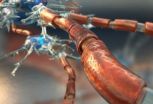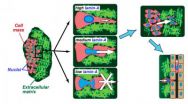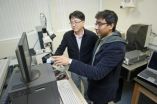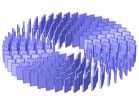(Press-News.org) Imagine a user who intends to send $2 to a friend through PayPal. Embedded malware in the user's laptop, however, converts the $2 transaction into a $2,000 transfer to the account of the malware author instead.
Researchers at Georgia Tech have created a prototype software, Gyrus, that takes extra steps to prevent malware from sending spam emails and instant messages, and blocking unauthorized commands such as money transfers.
Current protection programs might recognize the original user's intent to send email, transfer money or engage in other transactions, but cannot verify the specifics such as email contents or amount of money. Without context, it is impossible to properly verify the user's full intent, regardless of whether the software is protecting a financial transfer, an industrial control system or a wide range of other user-driven applications.
"Gyrus is a transparent layer on top of the window of an application. The user experience with the application will be exactly the same as when Gyrus is not installed or activated. Of course, if Gyrus detects that user-intended data has been tampered with, it will block the traffic and also notify the user," explained Wenke Lee, director of the Georgia Tech Information Security Center (GTISC).
The Georgia Tech research is based on the observation that for most text-based applications, the user's intent will be displayed entirely on screen, as text, and the user will make modifications if what is on screen is not what he or she wants. Users help Gyrus do its job by establishing pre-defined rules that help the software determine whether commands—authorized or not—fit with established user intentions. In the researchers' words, Gyrus implements a "What You See Is What You Send" (WYSIWYS) policy.
"The idea of defining correct behavior of an application by capturing user intent is not entirely new, but previous attempts in this space use an overly simplistic model of the user's behavior," said Yeongjin Jang, the Georgia Tech Ph.D. student who led the study.
"For example, they might infer a user's intent based on a single mouse click without capturing any associated context so the attackers can easily disguise attacks as a benign behavior," Jang added. "Instead, Gyrus captures richer semantics including both user actions and text contents, along with applications semantics, to make the system send only user-intended network traffic. Gyrus indirectly but correctly determines user intent from the screen that is displayed to the user. "
There are two key components to Gyrus' approach. First, it captures the user's intent and interactions with an application. Second, it verifies that the resulting output can be mapped back to the user's intention. As a result, the application ensures accurate transactions even in the presence of malware.
INFORMATION:
Jang, along with Simon Chung, a postdoctoral researcher at Georgia Tech, and Bryan Payne, a Georgia Tech Ph.D. graduate, presented the study in February during the 2014 Network and Distributed System Security Symposium (NDSS) in San Diego, Calif. Their advisor is Wenke Lee, director of the Georgia Tech Information Security Center (GTISC).
Georgia Tech project ensures 'what you see is what you send'
Prototype application takes extra steps to block malware from altering messages, transactions
2014-02-25
ELSE PRESS RELEASES FROM THIS DATE:
Unhealthy attachments
2014-02-25
(Santa Barbara, Calif.) — Using the surface forces apparatus and an atomic force microscope, researchers at UC Santa Barbara have taken a molecular approach to myelin membrane interactions, leading to insights into demyelinating diseases, such as multiple sclerosis. Their research is published in the Proceedings of the National Academy of the Sciences.
For a healthy nervous system, axons — the long projections of our nerve cells that run throughout our bodies — must be properly insulated. Much like conventional power cords need electrical insulators around the conducting ...
Penn researchers show nuclear stiffness keeps stem cells and cancer cells in place
2014-02-25
Adult stem cells and cancer cells have many things in common, including an ability to migrate through tiny gaps in tissue. Both types of cells also experience a trade-off when it comes to this ability; having a flexible nucleus makes migration easier but is worse at protecting the nucleus' DNA compared to a stiffer nucleus. Nuclear proteins that regulate nuclear stiffness are therefore thought to control processes as diverse as tissue repair and tumor growth.
In a study published in the Journal of Cell Biology, researchers at the University of Pennsylvania have shown ...
Climate engineering: Minor potential, major side effects
2014-02-25
Despite international agreements on climate protection and political declarations of intent, global greenhouse gas emissions have not decreased. On the contrary, they continue to increase. With a growing world population and significant industrialization in emerging markets such as India and China the emission trend reversal necessary to limit global warming seems to be unlikely. Therefore, large-scale methods to artificially slow down global warming are increasingly being discussed. They include proposals to fertilize the oceans, so that stimulated plankton can remove ...
Breast-feeding benefits appear to be overstated, according to study of siblings
2014-02-25
COLUMBUS, Ohio – A new study comparing siblings who were fed differently during infancy suggests that breast-feeding might be no more beneficial than bottle-feeding for 10 of 11 long-term health and well-being outcomes in children age 4 to 14.
The outlier was asthma, which was associated more with breast-feeding than with bottle-feeding.
The study also included an analysis of outcomes across families of different races and socioeconomic circumstances for comparison purposes, and those results matched other studies suggesting that breast-feeding's benefits to children ...
Smartphone-based voting technology may lead to fewer user errors
2014-02-25
Many U.S. counties have incorporated electronic voting technology, largely in response to well-publicized challenges related to older mechanical and punch-card models. Although these updated systems have solved some usability problems, they present a new set of issues for voters unfamiliar with the technology. A new study published in Human Factors examines how smartphone-based voting systems can be incorporated into the current large-scale election process.
"Current electronic voting systems have numerous issues - from usability and accessibility to security to the ...
New approach to chip design could yield light speed computing
2014-02-25
Every second, your computer must process billions of computational steps to produce even the simplest outputs. Imagine if every one of those steps could be made just a tiny bit more efficient. "It would save precious nanoseconds," explained Northeastern University assistant professor of physics Swastik Kar.
Kar and his colleague Yung Joon Jung, an associate professor in the Department of Mechanical and Industrial Engineering, have developed a series of novel devices that do just that. Their work was published recently in the journal Nature Photonics.
Last year, the ...
Geology covers Mars, the Moon, anthropogenic lead poisoning, earthquake hazards, and more
2014-02-25
Boulder, Colo., USA – The Geological Society of America's top journal, Geology, displays its multidisciplinary best in this latest posting. Earth science disciplines covered include geoarchaeology, climatology, invertebrate paleontology, sedimentology, geomorphology, seismology, planetary geology, geochemistry, glaciology, plate tectonics, mineralogy, and environmental and medical geology. Locations include Mars; Earth's moon; India; the Tibetan Plateau; the Saskatchewan River; L'Aquila, Italy; the Antarctic; Australia; the Andes; the San Andreas fault system; and Kume ...
Scientists twist sound with metamaterials
2014-02-25
WASHINGTON D.C. Feb. 25, 2014 -- A Chinese-U.S. research team is exploring the use of metamaterials -- artificial materials engineered to have exotic properties not found in nature -- to create devices that manipulate sound in versatile and unprecedented ways.
In the journal Applied Physics Letters, the team reports a simple design for a device, called an acoustic field rotator, which can twist wavefronts inside it so that they appear to be propagating from another direction.
"Numerous research efforts have centered on metamaterial-based devices with fascinating wave-control ...
Improvement in polymers for aviation
2014-02-25
We live surrounded by polymers and today, rather than come up with new polymers, there is a tendency to modify them in order to obtain new applications. Carbon nanotubes have excellent mechanical properties, are very tough, very rigid, and what is more, they conduct electricity. "The problem with them is that they get dispersed, in other words, it's very difficult to get them to blend with polymers," explained Iñaki Eguiazabal, a member of the Polymer Technology Group. That is why it is essential to come up with methods that will enablethe carbon nanotubes to have a ...
'Greener' aerogel technology holds potential for oil and chemical clean-up
2014-02-25
MADISON, Wis. – Cleaning up oil spills and metal contaminates in a low-impact, sustainable and inexpensive manner remains a challenge for companies and governments globally.
But a group of researchers at the University of Wisconsin–Madison is examining alternative materials that can be modified to absorb oil and chemicals without absorbing water. If further developed, the technology may offer a cheaper and "greener" method to absorb oil and heavy metals from water and other surfaces.
Shaoqin "Sarah" Gong, a researcher at the Wisconsin Institute for Discovery (WID) ...
LAST 30 PRESS RELEASES:
University of Oklahoma researcher awarded funding to pursue AI-powered material design
Exploring how the visual system recovers following injury
Support for parents with infants at pediatric check-ups leads to better reading and math skills in elementary school
Kids’ behavioral health is a growing share of family health costs
Day & night: Cancer disrupts the brain’s natural rhythm
COVID-19 vaccination significantly reduces risk to pregnant women and baby
The role of vaccination in maternal and perinatal outcomes associated with COVID-19 in pregnancy
Mayo Clinic smartwatch system helps parents shorten and defuse children's severe tantrums early
Behavioral health spending spikes to 40% of all children’s health expenditures, nearly doubling in a decade
Digital cognitive behavioral treatment for generalized anxiety disorder
Expenditures for pediatric behavioral health care over time and estimated family financial burden
Air conditioning in nursing homes and mortality during extreme heat
The Alps to lose a record number of glaciers in the next decade
What makes a good proton conductor?
New science reporting guide published for journalists in Bulgaria
New international study reveals major survival gaps among children with cancer
New science reporting guide published for journalists in Turkey
Scientists develop a smarter mRNA therapy that knows which cells to target
Neuroanatomy-informed brain–machine hybrid intelligence for robust acoustic target detection
Eight SwRI hydrogen projects funded by ENERGYWERX
The Lundquist Institute and its start-up company Vitalex Biosciences Announces Strategic Advancement of Second-Generation fungal Vaccine VXV-01 through Phase 1 Trials under $40 Million Competitive Con
Fine particles in pollution are associated with early signs of autoimmune disease
Review article | Towards a Global Ground-Based Earth Observatory (GGBEO): Leveraging existing systems and networks
Penn and UMich create world’s smallest programmable, autonomous robots
Cleveland researchers launch first major study to address ‘hidden performance killer’ in athletes
To connect across politics, try saying what you oppose
Modulating key interaction prevents virus from entering cells
Project explores barriers to NHS career progression facing international medical graduates
Jeonbuk National University researchers explore the impact of different seasonings on the flavor perception of Doenjang soup
Two Keck Medicine of USC Hospitals named Leapfrog Top Teaching Hospitals
[Press-News.org] Georgia Tech project ensures 'what you see is what you send'Prototype application takes extra steps to block malware from altering messages, transactions





